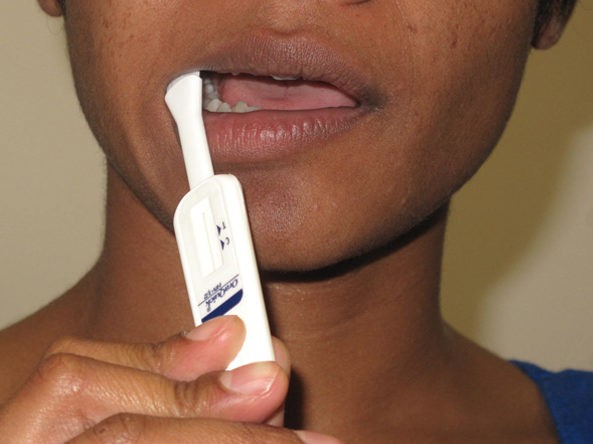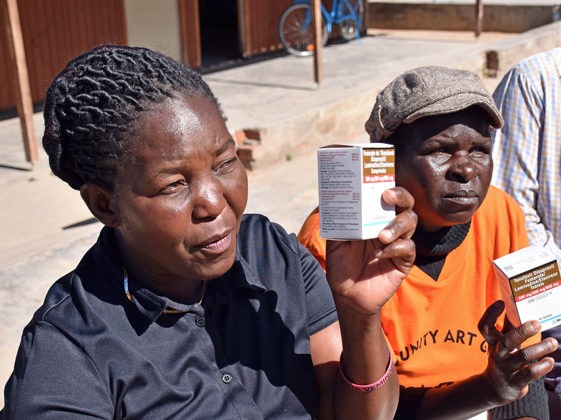Article and Study Summary
HIV incidence among women using intramuscular depot medroxyprogesterone acetate, a copper intrauterine device, or a levonorgestrel implant for contraception: A randomised, multicentre, open-label trial.
Published in:
The Lancet. Published online June 13, 2019.
DOI: http://dx.doi.org/10.1016/S0140-6736(19)31288-7
Authors:
Evidence for Contraceptive Options and HIV Outcomes (ECHO) Trial Consortium
Summary:
This randomized, multi-center, open-label trial compared HIV incidence among women using intramuscular depot medroxyprogesterone acetate (DMPA-IM), a copper intrauterine device, or a levonorgestrel implant as a contraceptive method. HIV-negative women, 16-35 years of age, seeking effective contraception in Eswatini, Kenya, South Africa, and Zambia were randomized to receive one of the three contraceptive methods and followed for 18 months. The primary outcome of interest was incident HIV infection during follow-up. Secondary outcomes included pregnancy rates and safety. HIV incidence was very high at 3.8%, with no significant difference by contraceptive method, and all of the methods were found to be safe and effective in this population. These results do not support previous observational and laboratory evidence suggesting that hormonal contraception, especially DMPA-IM, increases susceptibility to HIV infection. The results of this study justify expanding access to these contraceptive methods for women of reproductive age in similar high-risk settings, and highlight the need for comprehensive, integrated HIV and STI prevention services, especially in family planning settings.
Discussion Questions:
- How could the results presented in this article inform the programs that you work with?
- What programmatic challenges do you foresee in expanding access to the contraceptive methods evaluated in this study? Do you have any experiences to share?
Please share your thoughts and experiences with us in the comments section below.
Full Synopsis:
PDF version available in English, French, and Portuguese.
Study Summary
This randomized, multi-center, open-label trial compared HIV incidence among women using intramuscular depot medroxyprogesterone acetate (DMPA-IM), a copper intrauterine device (IUD), or a levonorgestrel (LNG) implant as a contraceptive method.
Study Setting
- Twelve research sites in Eswatini (1), Kenya (1), South Africa (9), and Zambia (1) located in areas with high HIV incidence.
Methods
- Women were eligible to participate in the trial if they were aged 16–35 years, not pregnant, HIV-negative, sexually active or had a prior pregnancy in the last three months, desired effective contraception, had no medical contraindications to the study contraceptive methods, agreed to use their assigned method for 18 months, and reported not having used similar contraceptive methods in the previous six months.
- Participants were randomized (1:1:1) to the DMPA-IM group (150 milligrams/milliliter intramuscular injection every 3 months), copper IUD group, or LNG implant group at enrollment.
- Follow-up visits occurred at one month, and then every three months until month 18.
- At visits participants received HIV testing, contraceptive counseling, safety monitoring checks, and a comprehensive package of HIV prevention services including HIV risk reduction counseling, participant and partner HIV and sexually transmitted infection (STI) testing and management, condoms, and pre-exposure prophylaxis (PrEP) as it became a part of national guidelines.
- The primary endpoint was incident HIV infection occurring after enrollment.
- Secondary outcomes were pregnancy, serious adverse events, adverse events resulting in method discontinuation, and method continuation.
- The primary outcome was assessed through a modified intention-to-treat analysis that only included women who contributed at least one HIV test during follow-up.
Results: Study Population and Follow-up
- Between December 2015 and September 2017, 7,829 women were enrolled and randomly assigned, with 2,609 assigned to the DMPA-IM group, 2,607 to the copper IUD group, and 2,613 to the LNG implant group.
- The median age of participants was 23 years (interquartile range [IQR] 20–26), 81% were unmarried and 81% had been pregnant at least once.
- Forty-eight percent of the women reported no condom use with the last sexual act, and 7% reported more than one sex partner in the prior three months.
- STIs were common: 18% had C trachomatis, 5% had N gonorrhoeae, and 38% had herpes simplex virus type 2 at baseline.
- The follow-up period concluded in October 2018 with 91% of participants having attended each scheduled follow-up visit, amounting to 10,409 woman-years of follow-up for assessment of HIV incidence.
- Participants used their randomly assigned method for 92% of the woman-years of follow-up.
Results: Primary Outcomes
- Over the course of the study, 397 incident HIV infections occurred, with 36% occurring in the DMPA-IM group, 35% in the copper IUD group, and 29% in the LNG implant group.
- Overall HIV incidence was 3.81 per 100 woman-years (95% confidence interval [CI] 3.45–4.21), with an HIV incidence of 4.19 per 100 woman-years (95% CI 3.54–4.94) in the DMPA-IM group, 3.94 per 100 woman-years (95% CI 3.31–4.66) in the copper IUD group, and 3.31 per 100 woman-years (95% CI 2.74–3.98) in the LNG implant group.
- In the modified intention-to-treat analysis of the 7715 (99%) women who completed at least one post-randomization visit, the hazard ratios for HIV acquisition were 1.04 (95% CI 0.82–1.33, p = 0.72) for DMPA-IM compared with copper IUD, 1.23 (95% CI 0.95–1.59, p = 0.097) for DMPA-IM compared with LNG implant, and 1.18 (95% CI 0.91–1.53, p = 0.19) for copper IUD compared with LNG implant.
Results: Secondary Outcomes
- In total, 255 pregnancies occurred, with 71% (n = 181) of pregnancies occurring after discontinuation of the randomly assigned method.
- In continuous use analyses, pregnancy incidence was 0.61 per 100 woman-years (95% CI 0.36–0.96) in the DMPA-IM group, 1.11 per 100 woman-years (95% CI 0.77–1.55) in the copper IUD group, and 0.63 per 100 woman-years (95% CI 0.39–0.96) in the LNG implant group; the two hormonal methods had lower pregnancy incidence than the copper IUD (p=0.027 for DMPA-IM and p=0.042 for the LNG implant).
- Serious adverse events occurred in 3% (219/7,829) of participants; 2% (49/2,609) of participants in the DMPA-IM group, 4% (92/2,607) in the copper IUD group, and 3% (78/2,613) in the LNG implant group.
- Of the 250 serious adverse events, 14% (n = 35) were considered related to the contraceptive method; none in the DMPA-IM group, 22% (23/104) in the copper IUD group, and 13% (12/90) in the LNG implant group.
- Seven percent had an adverse event resulting in discontinuation of the randomly assigned method, with significantly fewer discontinuing DMPA-IM compared to the other two methods (4% discontinuation in the DMPA-IM group, vs. 8% in the copper IUD group, and 9% in the LNG implant group, p<0.0001 for both comparisons).
Critical Analysis
This randomized, multi-center, open-label trial found no significant difference in incident HIV infection among women using DMPA-IM, a copper IUD, or an LNG implant in high-incidence settings. All contraception methods were found to be safe and highly effective for pregnancy prevention. HIV incidence was high for all three groups.
The following points should be considered when interpreting the study findings:
- By necessity the study was not blinded for clinicians and participants; however, all personnel involved in end-point testing and review committees were masked to group assignments.
- The study was powered to observe an approximate 50% increase in HIV incidence between groups; therefore, smaller increases in incidence may not have been detected with this study. Even small effects on HIV incidence may be important in decision-making around contraception and HIV prevention.
- These findings cannot be generalized to other contraceptive methods that were not studied, and the risk of HIV acquisition without the use of contraception was not evaluated.
- PrEP was introduced into national guidelines while the study was ongoing, which may have affected HIV incidence rates. However, only 622 women reported PrEP use for a median duration of 85 days (IQR 39–96) before study exit, and women on PrEP only contributed 195 woman-years (2% of the total women-years of follow-up).
- Despite the individualized HIV prevention package provided to participants, HIV incidence and STI prevalence were very high in this population, highlighting the need for additional prevention strategies, including integration of PrEP with contraceptive services.
Implications
Observational and laboratory studies have previously suggested a link between the use of hormonal contraception, especially DMPA-IM, and increased susceptibility to HIV infection in women. However, this randomized trial in high-incidence settings did not find a significant difference in HIV risk among the three contraceptive methods evaluated, and all were safe and highly effective. These results justify expanding access to these contraceptive methods for women of reproductive age in these high-risk settings. The alarmingly high HIV and STI incidence rates observed among this group of women seeking effective contraception highlight the need for comprehensive, integrated HIV and STI prevention services, especially in family planning settings.
This article synopsis was written by Cassia Wells. Share your thoughts on this article or suggest an article for Journal Club by emailing her at caw2208@columbia.edu
Articles of Note
- Detecting disengagement from HIV care before it is too late: development and preliminary validation of a novel index of engagement in HIV care
- Circumcision to prevent HIV and other sexually transmitted infections in men who have sex with men: a systematic review and meta-analysis of global data
- Exploring social harms during distribution of HIV self‐testing kits using mixed‐methods approaches in Malawi









